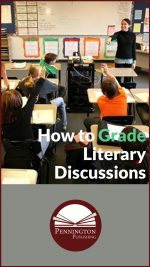How to Grade Literary Discussions
The longer I teach, the more I become a capitalist in my ELA classroom. Although I would love to have students participate in rich literary discussions out of their love for reading and passion for truth, it’s a rare student who speaks up out of such pure motives. Over the years, I admit it. I have succumbed to incentives and with good results. Life is compromise.
Students need to know that their participation in class discussion is an important part of their overall grade. Otherwise, many will avoid participation or perceive the group discussion as being of minimal importance. In the school setting, rewards such as grades, extra credit, treats, stickers, privileges are all weapons which the creative teacher can employ to motivate class participation in discussions. Short term, explicit rewards tend to work better than long term ones.
Here is how I organize a graded literary discussion. I select a student to record the points that classmates will earn. The recorder writes tally marks for positive discussion contributions on my class seating chart. The recorder gets two points for this task, but he or she gives up the opportunity to participate in the discussion. I have no problems finding student recorders for this task. Having a student recorder frees me up to lead the discussion without worrying about properly crediting responses. After a correct student response, I signal the recorder with my index finger and the recorder places a tally mark next to the name of the student. If the response is particularly insightful or directly responds to the response of another student, I may signal two fingers, for two tally marks. The latter must, of course, be accompanied by a resonating class “oooh!”
A good feature of this graded discussion technique is that it tracks student responses. During class discussion, I can survey the tally marks to determine who is failing to contribute or who is contributing excessively. I let students know that I will call on them, whether they raise their hands or not. I can also ensure that I am “calling on” male and female, ethnic sub-groups, etc. fairly. For the next graded class discussion, I have the recorder use a different color pen to differentiate the separate discussion grades.
Students perceive graded discussions as being fair and objective. Try announcing that the class will have a graded literary discussions the next day and students might just “cheat” by reading the assigned text and anticipating/preparing for your questions at home. What a shame! Of course, you could provide your discussion questions in advance and level them according to Costa’s Levels of Questioning, Depth of Knowledge, or Bloom’s Taxonomy, but the students might wind up teaching themselves. What a shame!
But, how can a teacher design a group discussion and lead the discussion to help students help themselves learn? Check out How to Lead Effective Group Discussions.
*****

The Science of Reading Intervention Program
The Science of Reading Intervention Program: Word Recognition includes explicit, scripted instruction and practice with the 5 Daily Google Slide Activities every reading intervention student needs: 1. Phonemic Awareness and Morphology 2. Blending, Segmenting, and Spelling 3. Sounds and Spellings (including handwriting) 4. Heart Words Practice 5. Sam and Friends Phonics Books (decodables). Plus, digital and printable sound wall cards and speech articulation songs. Print versions are available for all activities. First Half of the Year Program (55 minutes-per-day, 18 weeks)
The Science of Reading Intervention Program: Language Comprehension resources are designed for students who have completed the word recognition program or have demonstrated basic mastery of the alphabetic code and can read with some degree of fluency. The program features the 5 Weekly Language Comprehension Activities: 1. Background Knowledge Mentor Texts 2. Academic Language, Greek and Latin Morphology, Figures of Speech, Connotations, Multiple Meaning Words 3. Syntax in Reading 4. Reading Comprehension Strategies 5. Literacy Knowledge (Narrative and Expository). Second Half of the Year Program (30 minutes-per-day, 18 weeks)
The Science of Reading Intervention Program: Assessment-based Instruction provides diagnostically-based “second chance” instructional resources. The program includes 13 comprehensive assessments and matching instructional resources to fill in the yet-to-be-mastered gaps in phonemic awareness, alphabetic awareness, phonics, fluency (with YouTube modeled readings), Heart Words and Phonics Games, spelling patterns, grammar, usage, and mechanics, syllabication and morphology, executive function shills. Second Half of the Year Program (25 minutes-per-day, 18 weeks)
The Science of Reading Intervention Program BUNDLE includes all 3 program components for the comprehensive, state-of-the-art (and science) grades 4-adult full-year program. Scripted, easy-to-teach, no prep, no need for time-consuming (albeit valuable) LETRS training or O-G certification… Learn as you teach and get results NOW for your students. Print to speech with plenty of speech to print instructional components.
SCIENCE OF READING INTERVENTION PROGRAM RESOURCES HERE for detailed product description and sample lessons.
